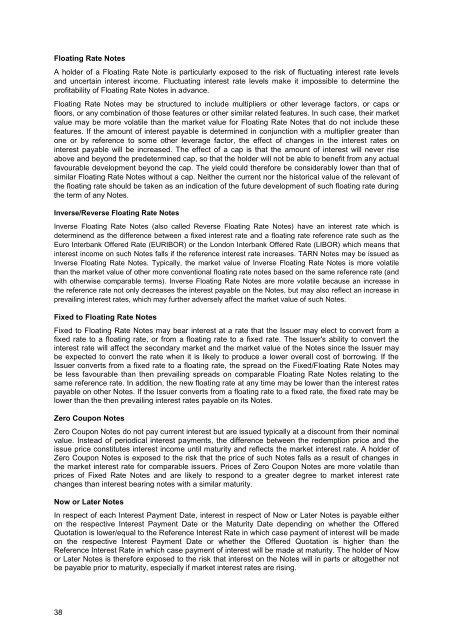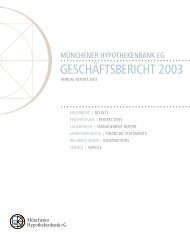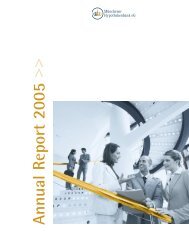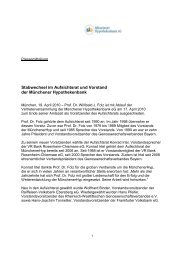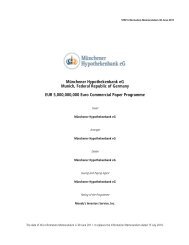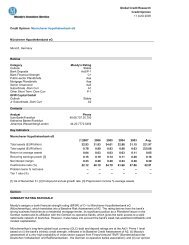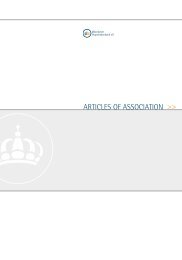Euro 25,000,000,000 Debt Issuance Programme - Münchener ...
Euro 25,000,000,000 Debt Issuance Programme - Münchener ...
Euro 25,000,000,000 Debt Issuance Programme - Münchener ...
Create successful ePaper yourself
Turn your PDF publications into a flip-book with our unique Google optimized e-Paper software.
Floating Rate Notes<br />
A holder of a Floating Rate Note is particularly exposed to the risk of fluctuating interest rate levels<br />
and uncertain interest income. Fluctuating interest rate levels make it impossible to determine the<br />
profitability of Floating Rate Notes in advance.<br />
Floating Rate Notes may be structured to include multipliers or other leverage factors, or caps or<br />
floors, or any combination of those features or other similar related features. In such case, their market<br />
value may be more volatile than the market value for Floating Rate Notes that do not include these<br />
features. If the amount of interest payable is determined in conjunction with a multiplier greater than<br />
one or by reference to some other leverage factor, the effect of changes in the interest rates on<br />
interest payable will be increased. The effect of a cap is that the amount of interest will never rise<br />
above and beyond the predetermined cap, so that the holder will not be able to benefit from any actual<br />
favourable development beyond the cap. The yield could therefore be considerably lower than that of<br />
similar Floating Rate Notes without a cap. Neither the current nor the historical value of the relevant of<br />
the floating rate should be taken as an indication of the future development of such floating rate during<br />
the term of any Notes.<br />
Inverse/Reverse Floating Rate Notes<br />
Inverse Floating Rate Notes (also called Reverse Floating Rate Notes) have an interest rate which is<br />
determinend as the difference between a fixed interest rate and a floating rate reference rate such as the<br />
<strong>Euro</strong> Interbank Offered Rate (EURIBOR) or the London Interbank Offered Rate (LIBOR) which means that<br />
interest income on such Notes falls if the reference interest rate increases. TARN Notes may be issued as<br />
Inverse Floating Rate Notes. Typically, the market value of Inverse Floating Rate Notes is more volatile<br />
than the market value of other more conventional floating rate notes based on the same reference rate (and<br />
with otherwise comparable terms). Inverse Floating Rate Notes are more volatile because an increase in<br />
the reference rate not only decreases the interest payable on the Notes, but may also reflect an increase in<br />
prevailing interest rates, which may further adversely affect the market value of such Notes.<br />
Fixed to Floating Rate Notes<br />
Fixed to Floating Rate Notes may bear interest at a rate that the Issuer may elect to convert from a<br />
fixed rate to a floating rate, or from a floating rate to a fixed rate. The Issuer's ability to convert the<br />
interest rate will affect the secondary market and the market value of the Notes since the Issuer may<br />
be expected to convert the rate when it is likely to produce a lower overall cost of borrowing. If the<br />
Issuer converts from a fixed rate to a floating rate, the spread on the Fixed/Floating Rate Notes may<br />
be less favourable than then prevailing spreads on comparable Floating Rate Notes relating to the<br />
same reference rate. In addition, the new floating rate at any time may be lower than the interest rates<br />
payable on other Notes. If the Issuer converts from a floating rate to a fixed rate, the fixed rate may be<br />
lower than the then prevailing interest rates payable on its Notes.<br />
Zero Coupon Notes<br />
Zero Coupon Notes do not pay current interest but are issued typically at a discount from their nominal<br />
value. Instead of periodical interest payments, the difference between the redemption price and the<br />
issue price constitutes interest income until maturity and reflects the market interest rate. A holder of<br />
Zero Coupon Notes is exposed to the risk that the price of such Notes falls as a result of changes in<br />
the market interest rate for comparable issuers. Prices of Zero Coupon Notes are more volatile than<br />
prices of Fixed Rate Notes and are likely to respond to a greater degree to market interest rate<br />
changes than interest bearing notes with a similar maturity.<br />
Now or Later Notes<br />
In respect of each Interest Payment Date, interest in respect of Now or Later Notes is payable either<br />
on the respective Interest Payment Date or the Maturity Date depending on whether the Offered<br />
Quotation is lower/equal to the Reference Interest Rate in which case payment of interest will be made<br />
on the respective Interest Payment Date or whether the Offered Quotation is higher than the<br />
Reference Interest Rate in which case payment of interest will be made at maturity. The holder of Now<br />
or Later Notes is therefore exposed to the risk that interest on the Notes will in parts or altogether not<br />
be payable prior to maturity, especially if market interest rates are rising.<br />
38


